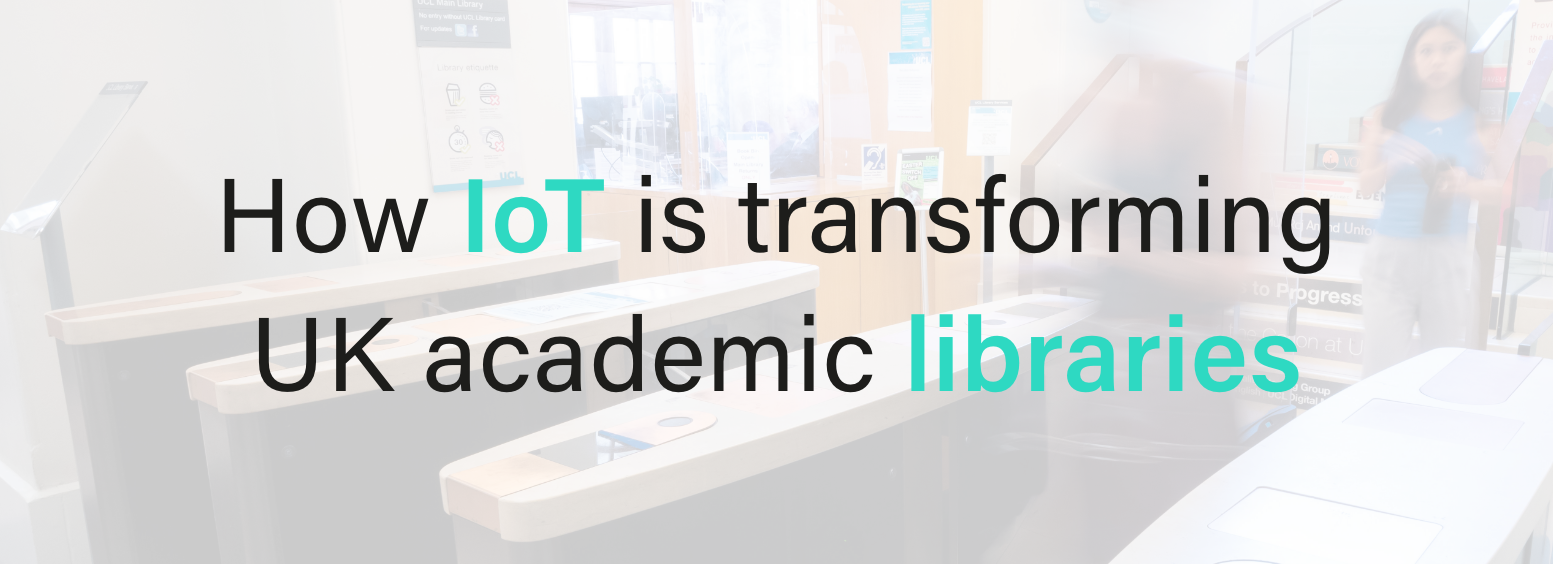From Imperial College London to Huddersfield University, academic libraries and their students, across the nation are reaping big benefits from the Internet of Things (IoT). Enhancing the student experience and driving better outcomes for both students and Universities, is the core motivation.
As centres of knowledge and collaboration, it’s not surprising that libraries are frequently at the forefront of the application of new technologies. One of the most significant recent trends is the proliferation of ‘smart libraries’ utilising the Internet of Things (IoT).
Sophisticated technology enables devices to communicate with each other or a central hub via the internet, so they can perform tasks automatically. These sophisticated systems produce a wealth of useful data that can be analysed to better manage facilities, make more informed decisions based on statistical data and factual evidence that all allows spaces, experiences, and resources to be optimised.
In the academic library environment, they are using a range of tools that include smart monitors and sensors, people counting, utilisation tools and technology that monitor and build the picture in the first place. Knowing how spaces are used, for what frequency, for what purpose, at what time and day of the week for what dwell time is just the starting place for ensuring utilisation of spaces is mutually beneficial and then enhanced for both the academic learning environment and to all those who are using it.
The driving force here is to provide the optimum ‘customer experience’ putting the student needs at the centre of the smart technologies and the knowledge gained to ensure modern spaces for learning, studying and engagement.
IoT: The Benefits for Libraries
The benefits are numerous, including:
Improving and enhancing the customer experience
Increased consumption of learning and resources
Increased efficiency
Increased productivity
Streamlined event management
Freeing up staff from laborious routine tasks meaning they are free to use their core skills doing what they do best
Reducing carbon footprint and environmental impact
Reduced security risks, and
Overall savings in time and money.
Smart libraries in action
But how does this actually work in practice?
The most obvious IoT application is the use of smart monitors, which report environmental data back to a central hub which in turn completes actions such as turning heating and lighting off when a room is not in use.
People counters are another handy application which can determine, for example, how many people are in attendance at a seminar or open day, in a library space etc. generating data which can be used to improve security, duty of care and event management.
Automated self-service kiosks have become an integral part of many UK academic libraries, providing an efficient way for students to check resources in and out and get a temporary access pass when they have mislaid a permanent pass. Self-service kiosks dramatically reduce queues and can also be used to issue visitor passes.
IoT systems have improved resource management for libraries, with the introduction of automated systems for booking rooms and desk space, as well as sorting books and scanning shelves. A shelf reading scanning unit enables library staff to perform a stocktake at the dizzying rate of 18,000 items an hour, so stocktaking can be completed more quickly and frequently.
We’re now also starting to see the emergence of smart public libraries where access is being increased over a 24/7 period making it truly customer centric, however it’s also entirely environmentally beneficial because the utilities are only activated when occupancy demands.
In a public setting we’re seeing customer convenience become a reality through the power of IoT.
In an academic library setting we’re seeing the IoT ensuring the customer experience for the student being at the forefront of developments and improvements.
AdvaNova expertise
At AdvaNova, we have been developing technology for British academic libraries for over 50 years – our clients include the University of Surrey, University of Oxford, University of Liverpool, University of London, University of Leeds, MK College, and the University of Birmingham.
We’re currently deploying a number of trial ‘Utilisation’ and ‘People Counting’ tests across various Universities in the UK. They are keen to understand the true reality of the utilisation and consumption of their various settings across the University sites and such trials allow them to start building the data, knowledge and statistic base that strategic decisions can been built upon.
One of our most recent projects was a complete self-service solution across all eight sites occupied by Imperial College London, which wanted to upgrade existing self-service equipment for a better customer experience as well as easier issue and return of books. Access the video here.
We enabled the University of Huddersfield to become one of the first universities in the UK to measure student attendance electronically across all parts of its campuses. This project involved the installation of more than 400 Wi-Fi-enabled student card readers to manage events and student retention data from a single centralised database.
We rolled out a similar system at the University of Bedfordshire, so the university could fulfil its requirement to track student attendance at teaching events. The shift from a paper-based to an electronic barcode capture system has resulted in significant savings in staff time and resources.








